Sculptures for Days (Classics Trip to Cambridge) – Oli Hurley
On Monday the 13th of March four intrepid explores of the academic field of A level classics (Louis Gibson, John Wells, Peter Dweryhouse and I, along with Mr Routledge) set off to the one place all academics see in either their nightmares or dreams, the mythical, and yet terrifying, Cambridge University. Why, you may ask, would you do something so brave and yet so controversial? To gaze upon plaster casters of ancient sculpture for an hour of course! what else does a classicist spend their time doing? And what a delight it was! some people may see those who find joy in staring at dusty olde statues boring, and not even the originals by god! But they just haven’t seen the look of pure chaotic ecstasy that can build on the face of one studying the subject. The look when they finally come face to face with the thing that was so vehemently haunting their life with its presence, as they had to drone into their head every date, artist and detail relating to each statue. Surly we are not boring people then, all that obviously sounds riveting!
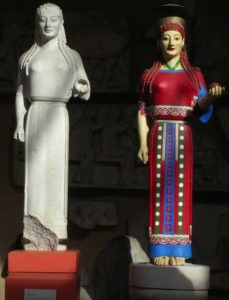
(The Peplos Kore – C.530 BCE)
As we made our merry way to our final destination we were met with many a trail and tribulation. For instance the unexpected chaos that is the morning traffic near Ipswich, as cars hopelessly pour into poorly constructed roundabouts and narrow country roads, luckily not taking us home to the place we belonged. This did however give us even more time to jam out to the one true radio station (that is in Mr Routledge’s opinion) GOLD, where about 4/10 songs were actually what we may have deemed an “absolute tune”. As the time before we arrived decreased so too did our enthusiasm for blasting out every single hit that GOLD relentlessly churned out, eventually resorting to the consumption of the infamous baggy meal just to appease our desire for any kind of excitement. This all changed however when what did we hear from GOLD, but Gold itself, and so we did believe in our souls, and we had the power to know, for about one verse until we got tired again and stopped singing.
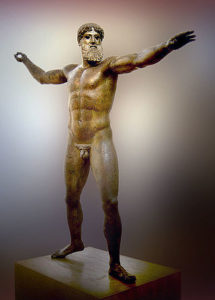
(The Artemission Zeus – C.460 BCE)
Finally, and thankfully, we arrived at the dark fortress of academia that is Cambridge university, and its eerie catacomb, the Classics department. Despite Mr Routledge almost forgetting where the department was, with a small amount of help on my part in navigating the concrete labyrinth, we eventually came to the museum itself. As soon as we entered we could instantly see around 4 of those iconic works with their artificial stone smiles of which we had been studying for the past year. Obviously they were much better in the flesh, or bronze and marble I guess. There was the Peplos Kore with its unnerving rigidity, terrifying smile and explosive colour, some such as the scholar Nigel Spivey may even have called it sexy….not us though. And over there the dominating Artemission Zeus, his dad bod shinning all in bronze, judging us with those soulless gemstone eyes, distracting us from the less impressive nature of his, and all the male statues, nether regions (its so they don’t look like male prostitutes, okay, get over it). All around us we were swarmed by masses of stoic faces, dramatic poses and extremely well sculpted drapery.
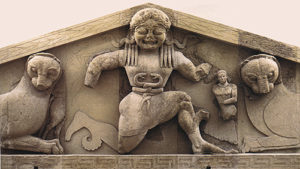
(The pediment of Artemis at Corfu – C.580 BCE)
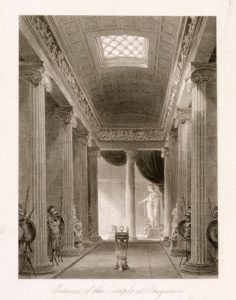
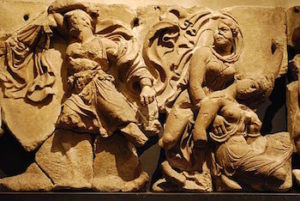
Personally my favourite piece has to be the Temple of Apollo Frieze at Bassae. It may not be the mot grandiose like the ginormous Parthenon pediments. It may not be the most artistically accomplished, simply look at some of the unnatural movements in it and you’ll see why. And it may not be the most imposing like the horrifying Medusa Pediment at Corfu. But there is something very special about this frieze, the pure sense of chaos and suffering that it is able to bring across really resonates with me. There’s a great sense of pathos in the scene as you observe Amazons holding their dying friends in their arms and the lifeless bodies of the discarded. There is, however, one other reason I love this sculpture, and that is it’s placement within rather than outside of the temple. It has been suggested that this placement would have cause the light that entered from outside to dance across the scene, giving it a sense of motion and an extra sense of chaos and at times despair. The fact too that one could simply turn around and see the whole frieze, almost like a panning shot in a cinema, truly brings the scene to life.
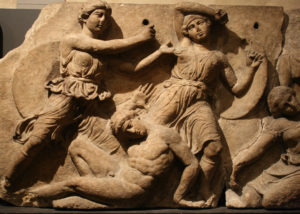
(The Frieze of the Temple of Apollo at Bassae – C.420 BCE)
The trip really was a marvellous way to help us all remember accurately many of the minute details regarding how the sculptures would have been perceived by onlookers. So too do I believe this form of learning, by experiencing, by being a part of what you are learning, is honestly one of the best ways to learn. And so I would advise you to make the most of these kinds of trips, and to take part in as many as you can, I assure you it’ll help with your success in the long run.
By Oli Hurley

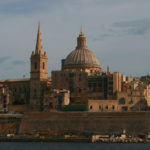
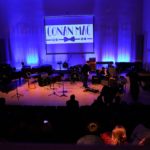












Post Comment
You must be logged in to post a comment.